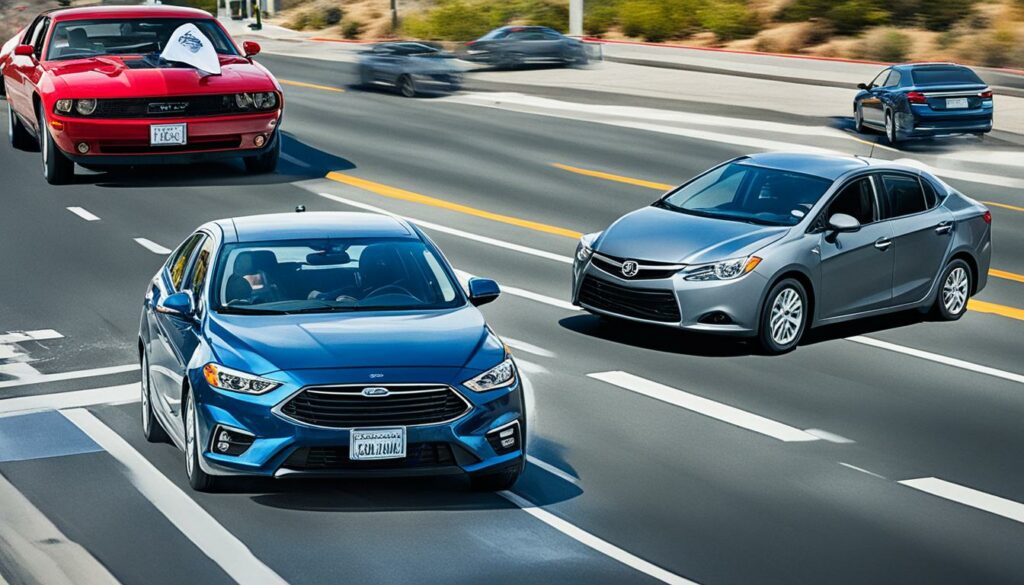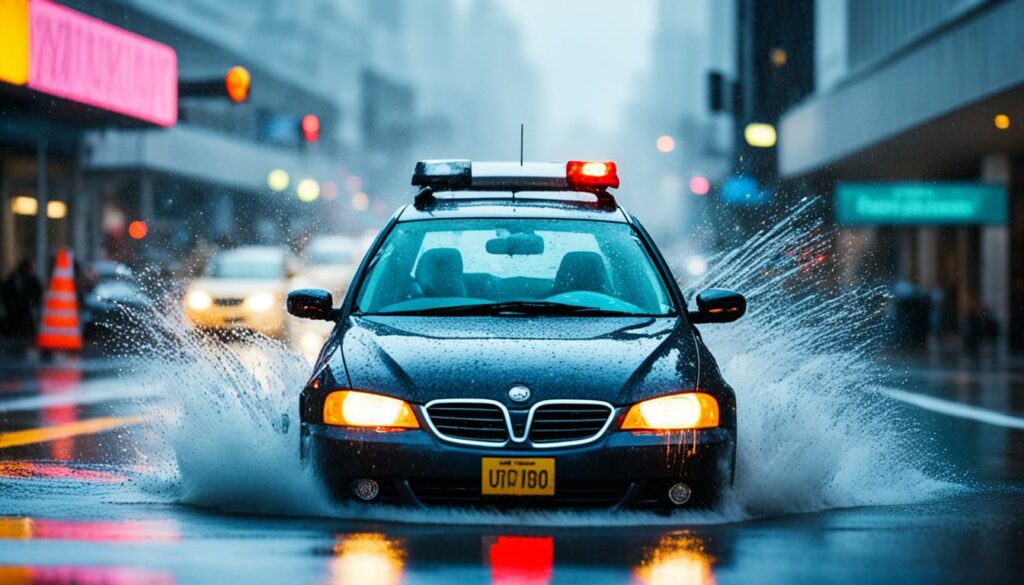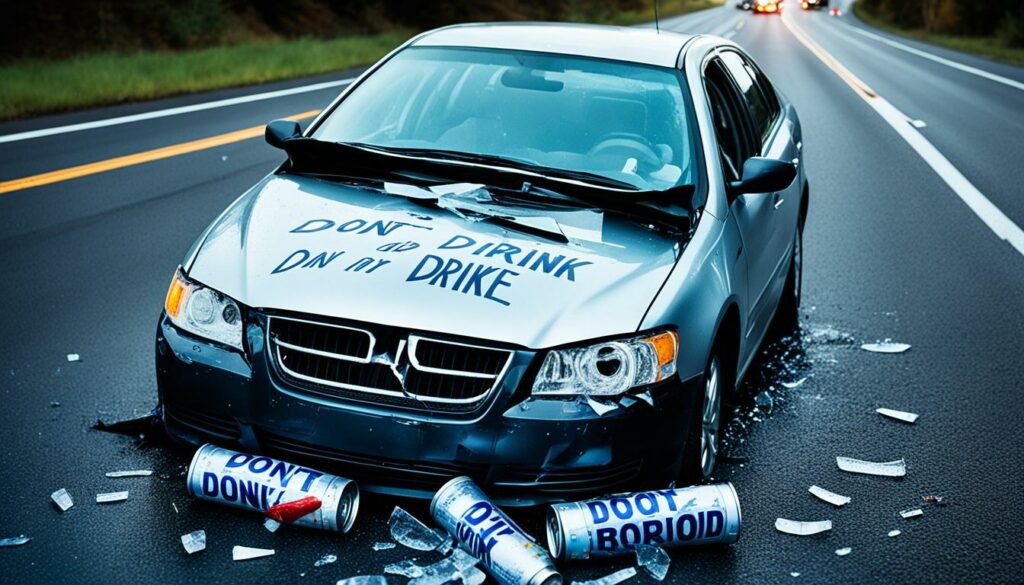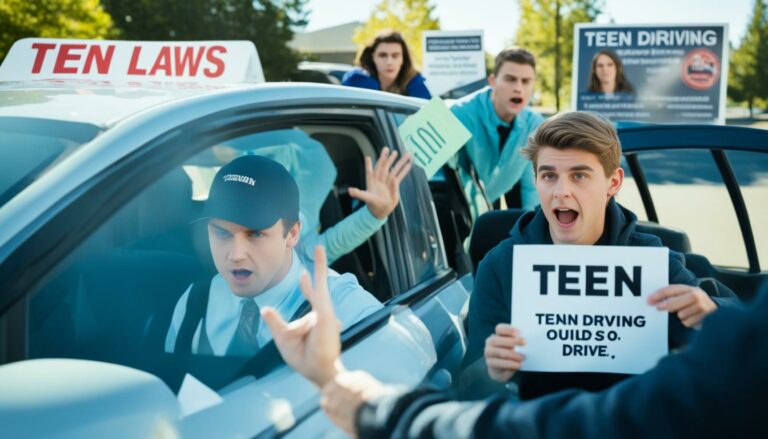Driving Risks: Examples on the Road to Heed
When it comes to driving, the road can be full of risks that we should be aware of. Understanding these risks and the factors that contribute to them is crucial for promoting safe driving practices. In this article, we will explore some common examples of driving risks and the behaviors that can make our time on the road dangerous.
One of the riskiest groups on the road are newly licensed and younger drivers. Inexperience plays a significant role in this, as these drivers are more prone to making mistakes and misjudgments. Distractions, such as cell phone use and texting, can also divert their attention from the road, increasing the likelihood of accidents. Additionally, excessive speeding is another dangerous behavior often exhibited by young drivers.
Drinking and driving is a major risk factor among young drivers, particularly those in their late teens. This behavior impairs their judgment and coordination, putting themselves and others at risk. It is important to note that male teenagers are more frequently involved in car crashes than their female counterparts.
However, it’s not all bad news. The presence of an adult passenger can reduce the crash rates for teenage drivers, providing some positive reinforcement for responsible driving practices.
By understanding the risks and behaviors associated with driving, we can take measures to protect ourselves and others. Let’s delve deeper into the risk factors for teenage drivers and explore strategies for managing these risks.
Key Takeaways:
- Newly licensed and younger drivers face higher crash rates due to inexperience, distractions, and excessive speeding.
- Drinking and driving is a significant risk among young drivers, especially in their late teens.
- Male teenagers are more involved in car crashes than females.
- An adult passenger can help reduce crash rates for teenage drivers.
- Understanding driving risks and behaviors is vital for promoting safe driving practices.
Risk Factors for Teenage Drivers

When it comes to driving, teenagers face a unique set of challenges that increase their risk on the road. Understanding these risk factors is crucial for promoting safe driving practices among young drivers.
Inexperience: A Major Risk Factor
Inexperience is the most significant risk factor for teenage drivers. Newly licensed drivers and teenagers, in general, have the highest crash rates compared to other age groups. The lack of experience behind the wheel makes it difficult for them to anticipate and respond to potential hazards.
Distraction: A Common Danger
Another common risk factor among teenage drivers is distraction. In today’s digital age, cell phone use and texting while driving have become significant distractions for young drivers. Taking their eyes off the road for even a few seconds can have devastating consequences.
“Distracted driving is never worth the risk. It only takes a moment of distraction to cause a lifetime of regret.” – Anonymous
Excessive Speeding and Risky Behaviors
Teenagers often engage in excessive speeding and other risky driving behaviors. The thrill of the open road combined with a sense of invincibility can lead them to push the limits. Driving at excessive speeds and following too closely to other vehicles increases the likelihood of accidents for teenage drivers.
The Emerging Risk of Drinking and Driving
While not very common among novice teenage drivers, drinking and driving becomes more prevalent as they enter their later teen years and young adulthood. Alcohol impairs judgment, coordination, and reaction time, significantly increasing the risk of accidents.
By addressing these risk factors and providing education and support, we can help teenage drivers develop safer driving habits and reduce the number of accidents on our roads.
| Risk Factors | Impact on Teenage Drivers |
|---|---|
| Inexperience | Difficulties in anticipating and responding to hazards |
| Distraction | Increased likelihood of accidents due to cell phone use and texting |
| Excessive Speeding and Risky Behaviors | Higher crash rates due to driving at excessive speeds and engaging in risky behaviors |
| Drinking and Driving | Impaired judgment, coordination, and reaction time leading to a higher risk of accidents |
Influences on Teenage Driving Behavior

Risky driving behaviors among teenage drivers are influenced by various factors. Understanding these influences is crucial for promoting safe driving habits and reducing the risk of accidents. Two significant influences on teenage driving behavior are social norms and the presence of teenage passengers.
Social Norms
Social norms play a significant role in shaping teenage driving behavior. Research has shown that teens who perceive their friends as engaging in risky driving behavior are more likely to imitate those behaviors themselves. When teenagers believe that risky driving is the norm among their peers, they may feel pressured to conform and engage in similar behaviors.
Teens who report that their friends drive in a risky manner are more likely to engage in risky driving themselves.
It is essential to address the influence of social norms by promoting positive peer norms and emphasizing the importance of safe driving practices. By encouraging teens to prioritize safety and understand the consequences of risky behavior, we can help create a culture of responsible driving among young drivers.
Teenage Passengers
The presence of teenage passengers in the car can significantly impact the driving behavior of teenage drivers. Studies have consistently shown that the risk of crashes increases when there are teenage passengers, particularly peers, in the vehicle. The presence of friends can create distractions, increase excitement, and lead to riskier driving decisions.
Having teenage passengers in the car also increases the risk of crashes for teenage drivers.
As passengers can influence the driver’s behavior, it is crucial for parents, guardians, and educators to discuss and enforce rules regarding the number and type of passengers allowed in the car when teenagers are driving. Implementing graduated driver licensing programs that restrict the number of passengers for newly licensed drivers can also help reduce the risk of accidents.
Risky Driving Situations
In addition to social norms and the presence of teenage passengers, certain driving situations pose higher risks for teenage drivers. For example, driving at night increases the likelihood of accidents due to reduced visibility and fatigue. Other risky driving situations include inclement weather conditions, heavy traffic, and unfamiliar routes.
It is crucial for teenage drivers to be aware of these risky driving situations and take appropriate precautions. This can include adjusting driving behavior, staying focused on the road, and avoiding unnecessary distractions.
| Risky Driving Situations | Tips for Teenage Drivers |
|---|---|
| Driving at night | – Ensure headlights are functioning properly – Reduce speed to compensate for reduced visibility – Take breaks if feeling fatigued |
| Inclement weather conditions | – Slow down and maintain a safe following distance – Use windshield wipers and headlights as necessary – Be cautious of icy or wet road surfaces |
| Heavy traffic | – Stay calm and patient – Maintain a safe distance from surrounding vehicles – Avoid aggressive maneuvers |
| Unfamiliar routes | – Plan the route in advance – Use navigation systems or maps for guidance – Focus on the road and avoid distractions |
By recognizing the influence of social norms and the presence of teenage passengers, as well as being aware of risky driving situations, teenage drivers can take proactive steps to prioritize safety and reduce the risk of accidents on the road.
Defensive Driving Tips for Safe Driving

Defensive driving techniques play a crucial role in reducing the risk of accidents on the road. By adopting a proactive mindset and implementing safe driving practices, you can enhance your safety and that of others around you. Here are some essential defensive driving tips to keep in mind:
- Stay focused on the road: Distractions while driving can significantly increase the risk of accidents. Avoid using cell phones, texting, or engaging in any other activities that divert your attention from the task at hand. Remember, a split second of distraction can have severe consequences.
- Obey speed limits: Speeding reduces your ability to react to unexpected situations. Adhering to speed limits allows for better reaction time and helps mitigate the severity of accidents. Always adjust your speed according to the prevailing road and traffic conditions.
- Be aware of other drivers: Defensive driving involves anticipating and responding to the actions of other drivers. Pay attention to their behavior, especially aggressive or reckless driving, and maintain a safe distance between your vehicle and others on the road.
- Expect the unexpected: Driving is unpredictable, and it’s important to be prepared for any situation. Scan the road ahead, check your mirrors regularly, and be ready to react to sudden lane changes, pedestrians, or any other potential hazards.
“Defensive driving is not about being fearful but being prepared. It empowers you to react swiftly and safely to unforeseen circumstances, ensuring a secure journey for yourself and others.” – Expert Driver
Implementing these defensive driving tips will help minimize the risk of accidents and contribute to a safer driving environment. Remember, safe driving is a collective responsibility that we all share on the roads.
| Defensive Driving Tips for Safe Driving |
|---|
| Stay focused on the road |
| Obey speed limits |
| Be aware of other drivers |
| Expect the unexpected |
[Continue Reading: Section 5 – Tips for Handling Specific Driving Hazards](#section-5)
Tips for Handling Specific Driving Hazards

When driving, it’s essential to be prepared for various hazardous situations on the road. Different driving hazards require specific strategies for safe navigation. Whether you encounter low-speed zones, hazardous weather conditions, or other risky driving situations, here are some tips to help you stay safe on the road.
Driving in Low-Speed Zones
“Pedestrian crossings and school zones demand extra caution to ensure the safety of everyone on the road,” says Lisa Thompson, a traffic safety expert at SafeDrive Magazine. “Always be aware of your surroundings and follow traffic controls and right-of-way rules.”
Handling Hazardous Weather Conditions
Driving in bad weather, such as heavy rain, snow, or low visibility, requires special attention and adjustments to your driving. “Reducing your speed and increasing your following distance can help you maintain control in these hazardous conditions,” advises Mark Johnson, a meteorologist at WeatherCentral. “Stay focused on the road, avoid distractions, and use your headlights to enhance visibility.”
Staying Focused in Hazardous Driving Conditions
Regardless of the driving hazards you encounter, distractions can amplify the risks. “Maintaining focus is crucial in hazardous driving conditions,” emphasizes Dr. Sarah Brown, a cognitive psychology expert. “Minimize distractions by refraining from using your cell phone or engaging in any activity that diverts your attention away from the road.”
| Hazardous Driving Condition | Tips for Safe Driving |
|---|---|
| Low-speed zones |
|
| Hazardous weather conditions |
|
| Risky driving situations |
|
Understanding the Consequences of Drinking and Driving

Drinking and driving is a dangerous behavior that can have severe consequences. Even one drink can impair a driver’s ability to operate a vehicle safely. Driving under the influence (DUI) or driving while intoxicated (DWI) can result in legal penalties, including fines, license suspension, and even imprisonment.
It is important to understand the risks and avoid getting behind the wheel after consuming alcohol. The consequences of impaired driving extend beyond legal repercussions. The potential physical harm caused by accidents resulting from drinking and driving can be immense, affecting not only the driver but also their passengers and innocent individuals on the road.
By making responsible choices and using alternative transportation options after consuming alcohol, individuals can help prevent the devastating consequences of drinking and driving.
“Drinking and driving is not only risking your own life but also the lives of others. It’s important to prioritize the safety of yourself and those around you by making responsible choices.”
The Severity of Legal Penalties for DUI
Driving under the influence carries a range of legal consequences that can have a lasting impact on an individual’s life. These penalties can vary depending on factors such as blood alcohol concentration (BAC) levels, previous convictions, and state-specific laws. Some of the common legal penalties for DUI include:
- Fines: DUI offenses often come with substantial monetary fines that can range from hundreds to thousands of dollars.
- License Suspension: Convictions for DUI can result in the suspension or revocation of an individual’s driver’s license, making it illegal for them to operate a vehicle for a specified period.
- Ignition Interlock Device: In some cases, individuals convicted of DUI may be required to install an ignition interlock device in their vehicles, which measures BAC levels and prevents the vehicle from starting if the driver’s BAC is above a certain limit.
- Probation: DUI offenders may be placed on probation, which typically involves regular check-ins with a probation officer and adherence to certain conditions.
- Imprisonment: Depending on the circumstances and severity of the offense, DUI convictions can lead to jail time, ranging from a few days to months or even years.
The specific penalties for DUI can vary, and it is essential to consult local laws and legal professionals to understand the consequences of impaired driving in a particular jurisdiction.
Protecting Lives Through Responsible Choices
Preventing the consequences of impaired driving begins with making responsible choices. It is crucial for individuals to understand their limits and avoid getting behind the wheel if they have consumed alcohol.
There are various alternatives to driving after drinking, including:
- Designated driver: Designating a sober driver before the occasion can ensure a safe return home.
- Public transportation: Utilizing buses, trains, or ride-sharing services can provide a reliable way to travel without driving under the influence.
- Taxi or rideshare: Calling a taxi or using rideshare apps like Uber or Lyft allows individuals to reach their destination safely.
- Stay overnight: If possible, arranging to stay overnight at the location or a nearby accommodation can prevent the need to drive after drinking.
By making responsible choices and understanding the potential consequences of impaired driving, individuals can prioritize their safety and the safety of others on the road.
Managing Risks in Winter Driving
Winter driving can present significant challenges and increased risks due to snow, ice, and poor visibility. It’s important to take precautions and adopt safe driving practices to ensure your safety on the road.
Here are some essential winter driving safety tips to help you navigate through bad weather conditions:
- Buckle up: Always wear your seatbelt, as it is your first line of defense in the event of an accident.
- Use extra caution in freezing areas: Be particularly mindful of areas that are prone to freezing quickly, such as bridges and shaded spots. These areas often become slippery first.
- Check weather reports: Stay informed about the current and forecasted weather conditions. This will help you plan your trips accordingly and make decisions that prioritize safety.
- Have an emergency kit: Keep an emergency kit in your car that includes items such as a flashlight, blanket, extra clothes, bottled water, non-perishable snacks, and a first-aid kit.
- Maintain a full tank of gas: Regularly fill up your gas tank, as it can help prevent fuel line freeze-up and ensure you have enough fuel in case you encounter unexpected delays or road closures.
- Adjust your driving speed: Reduce your speed and drive at a safe distance from the vehicle in front of you. This will give you more time to react to potential hazards and avoid collisions.
- Leave earlier: Allow yourself extra time to reach your destination. Leaving earlier will help you avoid rushing and driving recklessly in challenging road conditions.
By following these winter driving safety tips, you can minimize the risks associated with driving in bad weather and ensure a safer journey for yourself and others on the road.
Assessing and Managing Driving Risks
Evaluating driving risks is a crucial aspect of staying safe on the road. By considering factors such as personal well-being, road conditions, weather, and other road users, drivers can make informed decisions and take proactive measures to minimize potential hazards. Here are some essential strategies for assessing and managing driving risks:
- Conduct a Risk Assessment: Prior to each journey, perform a risk assessment by evaluating various factors that may affect your safety. Consider your physical and mental condition, the condition of your vehicle, and any potential risks associated with the route.
- Maintain Defensive Driving Techniques: Defensive driving plays a vital role in managing driving risks. Anticipate potential hazards, maintain a safe following distance, and keep an eye out for aggressive or distracted drivers.
- Stay Alert and Focused: Avoid distractions while driving. Keep your attention on the road by refraining from using mobile devices, adjusting the radio, or engaging in other activities that divert your focus.
- Communicate with Other Drivers: Use appropriate signals and gestures to communicate your intentions to other drivers on the road. Indicating lane changes, turns, or stops can help prevent potential collisions.
- Adjust Vehicle Position and Speed: In certain situations, such as when merging lanes or encountering potential hazards, adjust your vehicle’s position and speed to maintain a safe distance from other vehicles and avoid possible accidents.
“Defensive driving isn’t just a technique; it’s a mindset. It’s about being aware, staying focused, and being prepared for anything that may come your way.”
By incorporating these risk management strategies into your driving habits, you can enhance your overall safety and reduce the chances of accidents. Remember, defensive driving and consideration for other road users are essential for managing driving risks effectively.
| Risk Assessment Factors | Recommended Actions |
|---|---|
| Personal well-being | Ensure you are well-rested, alert, and free from impairment. |
| Road conditions | Adjust your driving behavior to accommodate factors such as wet or icy roads, construction zones, or heavy traffic. |
| Weather | Check weather forecasts and plan your route accordingly. Adjust your driving style to suit the weather conditions. |
| Other road users | Stay aware of the actions and intentions of other drivers, pedestrians, and cyclists. Anticipate potential risks and adjust your driving accordingly. |
Conclusion
Driving poses inherent risks, but by understanding common driving risks and adhering to safe driving practices, the likelihood of accidents and their consequences can be significantly reduced. It is crucial for drivers to remain focused and eliminate distractions while on the road. Additionally, practicing defensive driving techniques is essential for managing driving hazards and ensuring the safety of oneself and others.
By evaluating and effectively managing driving risks, drivers can contribute to creating safer road conditions. It is important to be aware of the various risk factors associated with driving, such as inexperience, distraction, excessive speeding, and hazardous driving conditions. By adopting safe driving practices and following traffic rules, drivers can play an active role in preventing accidents and promoting road safety.
Remember, safe driving requires a proactive approach. Regularly assess driving risks by considering personal well-being, road conditions, weather, and other drivers. Stay alert, communicate intentions clearly to other drivers, and adjust your speed and position to avoid or minimize potential crashes. Implementing defensive driving techniques and being considerate of other road users are vital for managing driving hazards.
FAQ
What are some examples of risks while driving?
Examples of risks while driving include distracted driving, excessive speeding, driving under the influence of drugs or alcohol, aggressive driving behaviors, and hazardous weather conditions.
What are the risk factors for teenage drivers?
Risk factors for teenage drivers include inexperience, distraction (especially from cell phone use and texting), excessive speeding, and peer influence. Drinking and driving also becomes a significant risk factor in the later teen years.
What influences teenage driving behavior?
Teenage driving behavior can be influenced by social norms, including the behavior of their peers and teenage passengers in the car. Certain situations, such as driving at night, can also contribute to higher risk levels for teenage drivers.
What are some defensive driving tips for safe driving?
Defensive driving tips for safe driving include maintaining focus and avoiding distractions, following speed limits and allowing for better reaction time, being aware of other drivers’ behaviors, and expecting the unexpected.
How can I handle specific driving hazards?
To handle specific driving hazards, it is important to exercise caution in low-speed zones, such as school zones or areas with high pedestrian traffic. In bad weather conditions, driving at slower speeds and increasing following distance is essential. Avoiding distractions and staying focused are key to navigating hazardous driving conditions safely.
What are the consequences of drinking and driving?
Drinking and driving can have severe consequences, including legal penalties such as fines, license suspension, and imprisonment. Even one drink can impair a driver’s ability to operate a vehicle safely, putting both themselves and others at risk.
How can I manage risks while driving in winter?
To manage risks while driving in winter, it is important to buckle up, use extra caution in freezing areas, and check weather reports before driving. Having an emergency kit in the car and ensuring a full tank of gas are also important for winter driving preparedness. Adjusting driving speed and leaving earlier to account for road conditions can reduce the risk of accidents.
How can I assess and manage driving risks?
To assess and manage driving risks, consider factors such as personal well-being, road conditions, weather, and other road users. Conduct a visual search, have a plan for alternate routes or emergency situations, stay alert, communicate intentions to other drivers, and adjust your vehicle’s position and speed to avoid or minimize potential crashes.
How can I reduce driving risks?
By practicing safe driving techniques, such as avoiding distractions, practicing defensive driving, and being considerate of other road users, you can significantly reduce the likelihood of accidents and their consequences. Maintaining focus, following speed limits, and practicing defensive driving are essential for reducing driving risks.







